Strategic Marketing: H&M and Gap's Approach to Business Objectives
VerifiedAdded on 2023/04/25
|22
|3917
|268
Report
AI Summary
This report provides a comparative analysis of H&M and Gap, focusing on how they utilize the marketing mix (Product, Price, Place, Promotion, People, Physical Evidence, and Process) to achieve their respective business objectives. It highlights similarities and differences in their strategies, such as product offerings, pricing tactics, distribution channels, and promotional activities. The report also includes a marketing plan for H&M, outlining goals like launching a couture collection, leveraging digital platforms, and customizing products based on customer data to enhance market share and profitability. The analysis underscores the importance of understanding and adapting the marketing mix to meet evolving consumer demands and competitive pressures in the fashion retail industry. Desklib provides a platform for students to access this report and other valuable study resources.

Briefing Paper
Paraphrase This Document
Need a fresh take? Get an instant paraphrase of this document with our AI Paraphraser
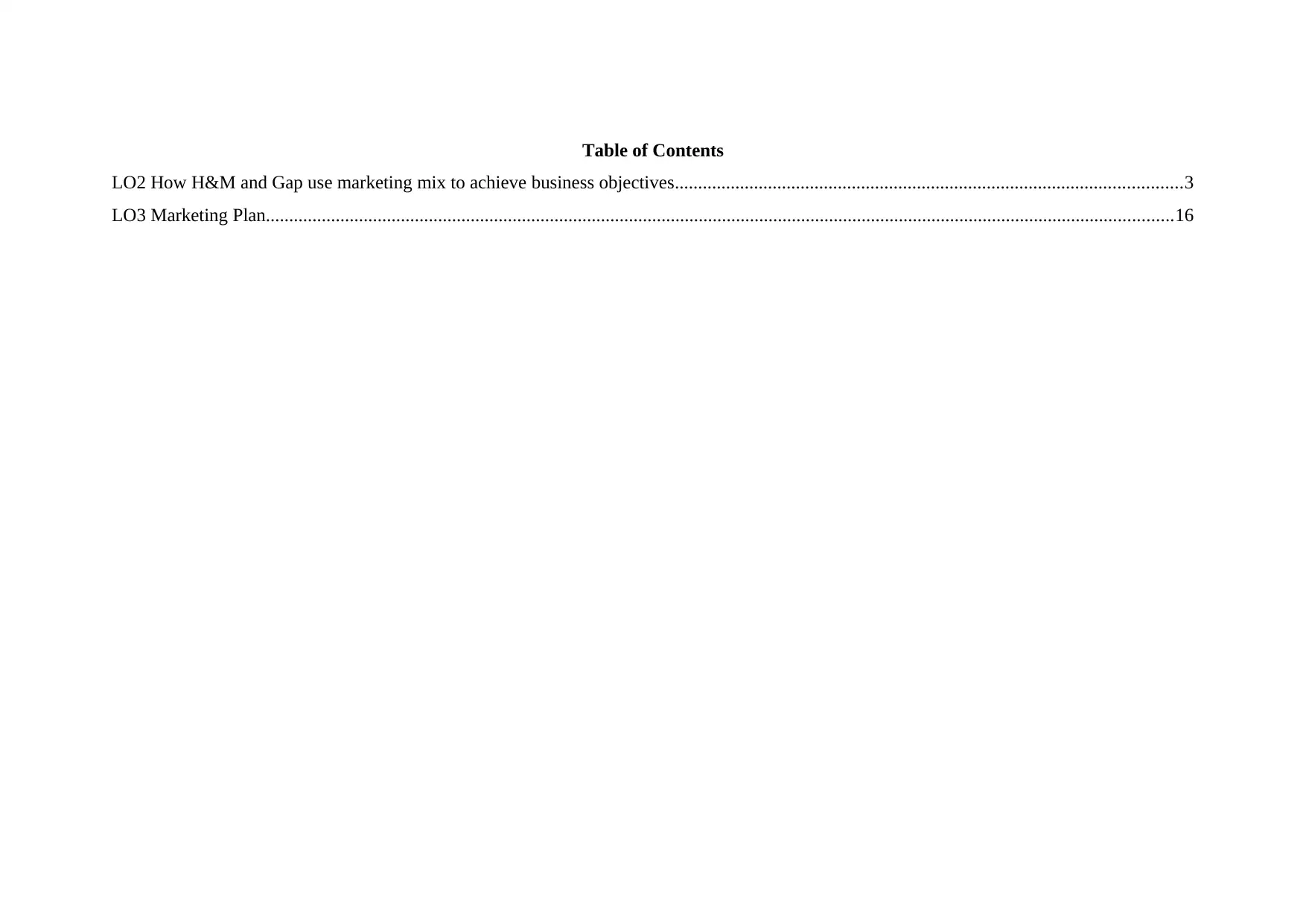
Table of Contents
LO2 How H&M and Gap use marketing mix to achieve business objectives.............................................................................................................3
LO3 Marketing Plan...................................................................................................................................................................................................16
LO2 How H&M and Gap use marketing mix to achieve business objectives.............................................................................................................3
LO3 Marketing Plan...................................................................................................................................................................................................16
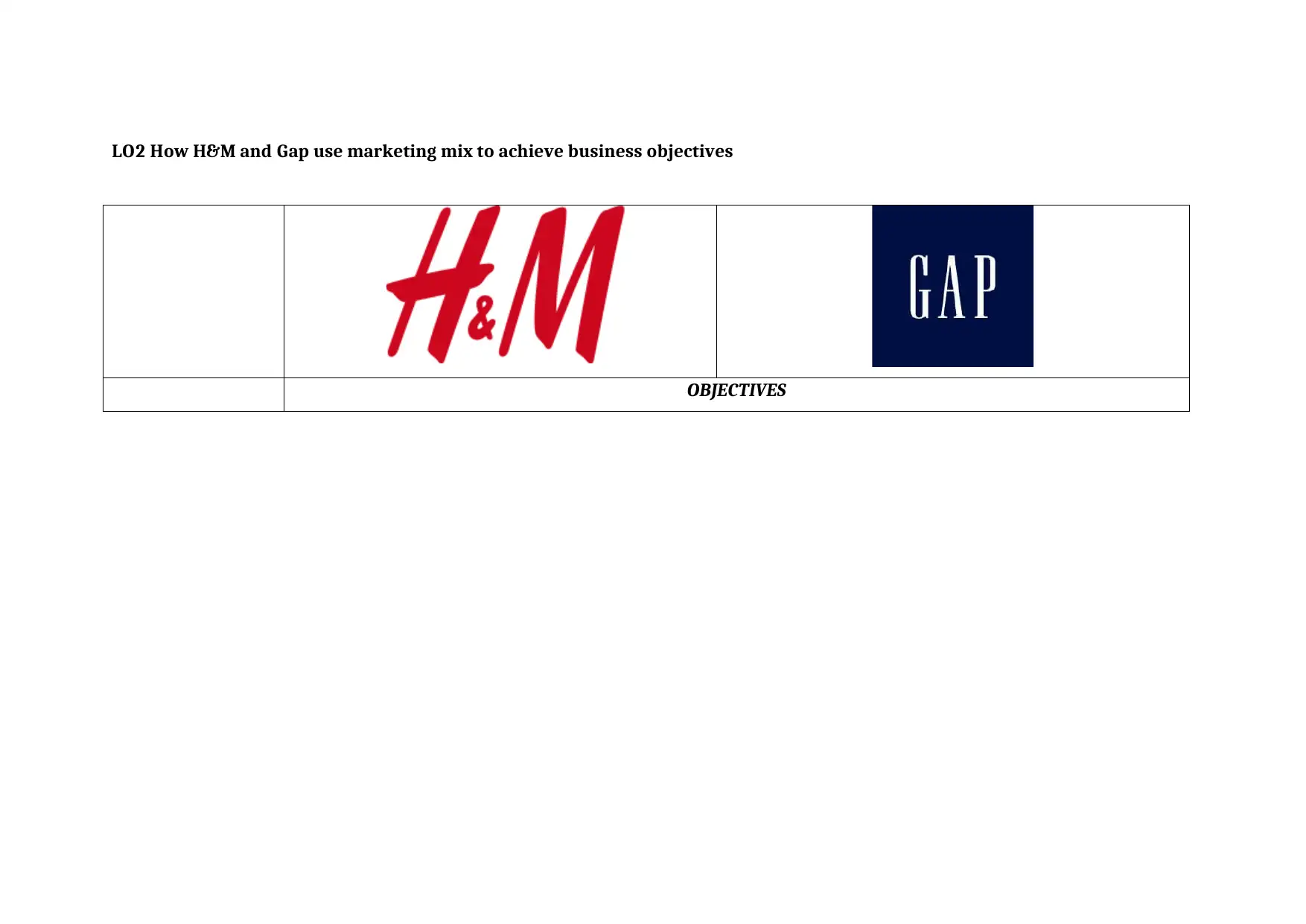
LO2 How H&M and Gap use marketing mix to achieve business objectives
OBJECTIVES
OBJECTIVES
⊘ This is a preview!⊘
Do you want full access?
Subscribe today to unlock all pages.

Trusted by 1+ million students worldwide
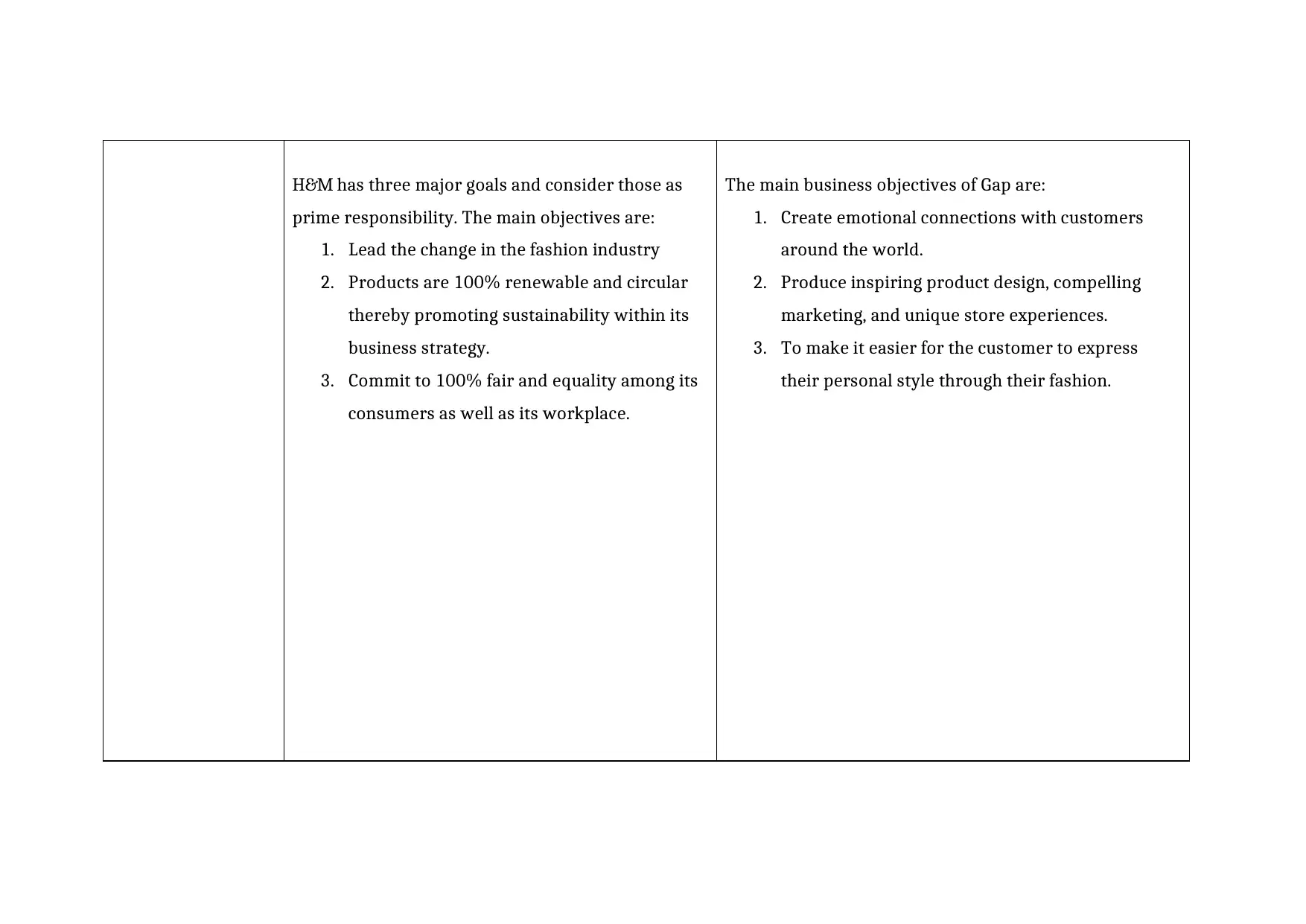
H&M has three major goals and consider those as
prime responsibility. The main objectives are:
1. Lead the change in the fashion industry
2. Products are 100% renewable and circular
thereby promoting sustainability within its
business strategy.
3. Commit to 100% fair and equality among its
consumers as well as its workplace.
The main business objectives of Gap are:
1. Create emotional connections with customers
around the world.
2. Produce inspiring product design, compelling
marketing, and unique store experiences.
3. To make it easier for the customer to express
their personal style through their fashion.
prime responsibility. The main objectives are:
1. Lead the change in the fashion industry
2. Products are 100% renewable and circular
thereby promoting sustainability within its
business strategy.
3. Commit to 100% fair and equality among its
consumers as well as its workplace.
The main business objectives of Gap are:
1. Create emotional connections with customers
around the world.
2. Produce inspiring product design, compelling
marketing, and unique store experiences.
3. To make it easier for the customer to express
their personal style through their fashion.
Paraphrase This Document
Need a fresh take? Get an instant paraphrase of this document with our AI Paraphraser
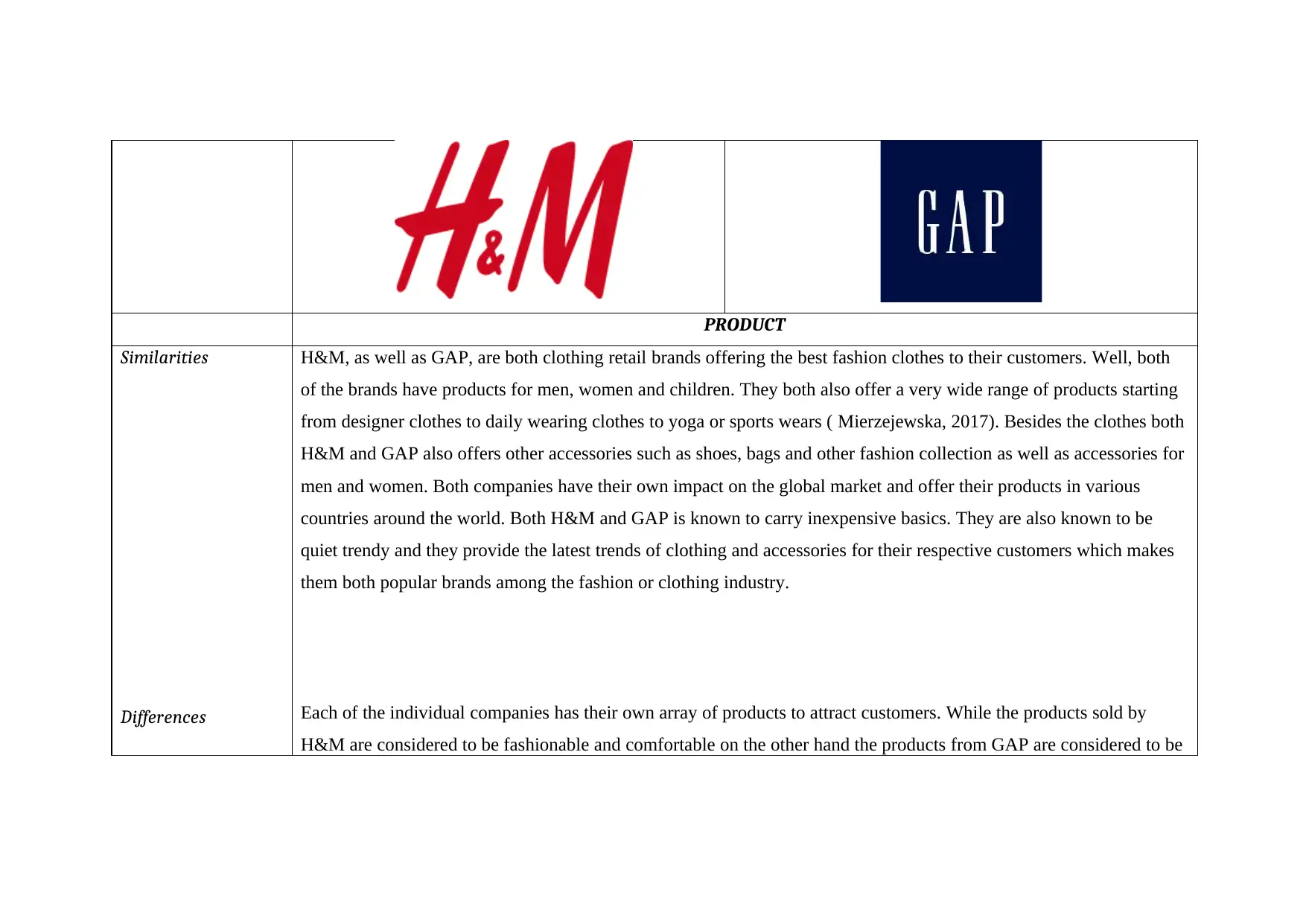
PRODUCT
Similarities
Differences
H&M, as well as GAP, are both clothing retail brands offering the best fashion clothes to their customers. Well, both
of the brands have products for men, women and children. They both also offer a very wide range of products starting
from designer clothes to daily wearing clothes to yoga or sports wears ( Mierzejewska, 2017). Besides the clothes both
H&M and GAP also offers other accessories such as shoes, bags and other fashion collection as well as accessories for
men and women. Both companies have their own impact on the global market and offer their products in various
countries around the world. Both H&M and GAP is known to carry inexpensive basics. They are also known to be
quiet trendy and they provide the latest trends of clothing and accessories for their respective customers which makes
them both popular brands among the fashion or clothing industry.
Each of the individual companies has their own array of products to attract customers. While the products sold by
H&M are considered to be fashionable and comfortable on the other hand the products from GAP are considered to be
Similarities
Differences
H&M, as well as GAP, are both clothing retail brands offering the best fashion clothes to their customers. Well, both
of the brands have products for men, women and children. They both also offer a very wide range of products starting
from designer clothes to daily wearing clothes to yoga or sports wears ( Mierzejewska, 2017). Besides the clothes both
H&M and GAP also offers other accessories such as shoes, bags and other fashion collection as well as accessories for
men and women. Both companies have their own impact on the global market and offer their products in various
countries around the world. Both H&M and GAP is known to carry inexpensive basics. They are also known to be
quiet trendy and they provide the latest trends of clothing and accessories for their respective customers which makes
them both popular brands among the fashion or clothing industry.
Each of the individual companies has their own array of products to attract customers. While the products sold by
H&M are considered to be fashionable and comfortable on the other hand the products from GAP are considered to be
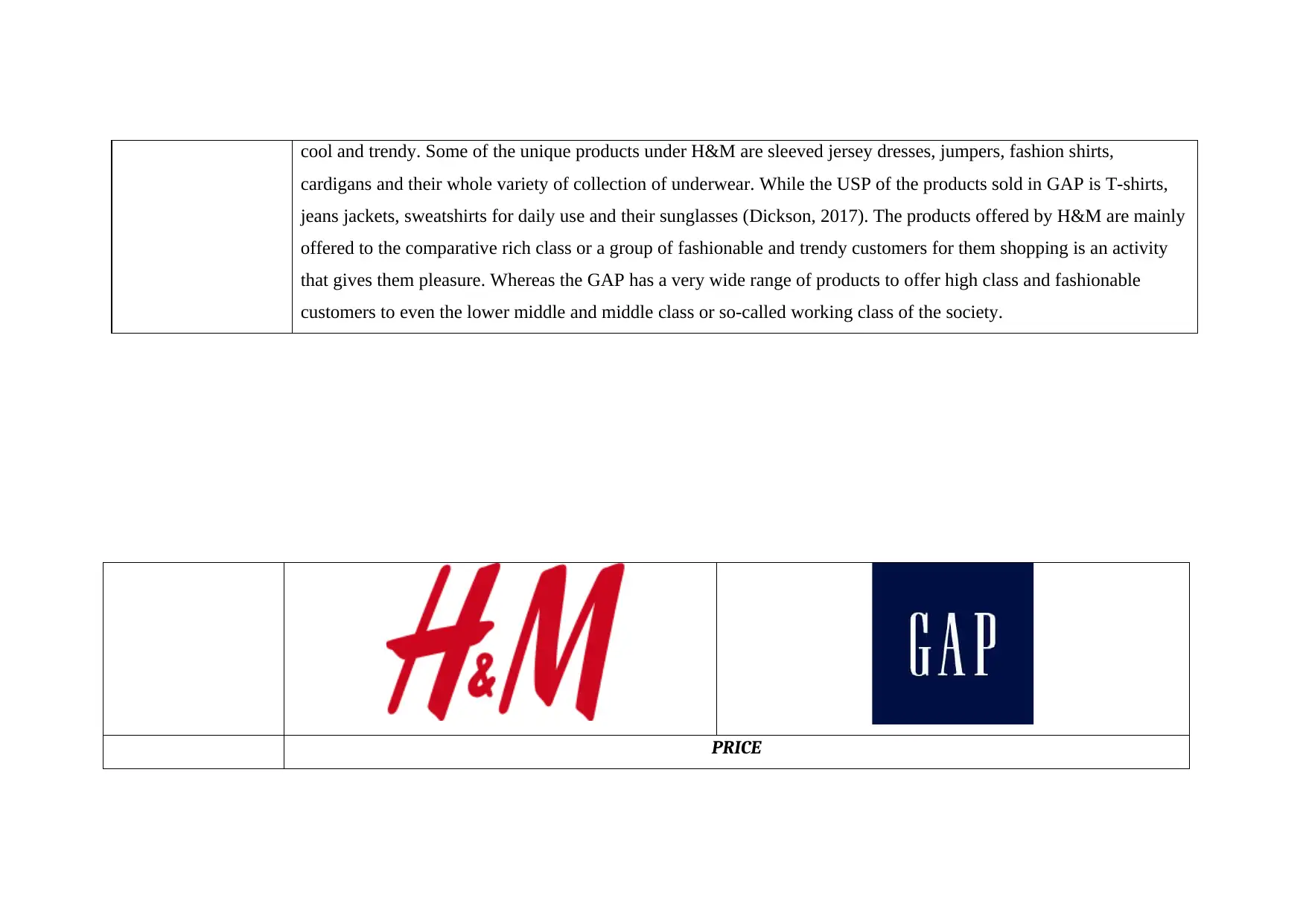
cool and trendy. Some of the unique products under H&M are sleeved jersey dresses, jumpers, fashion shirts,
cardigans and their whole variety of collection of underwear. While the USP of the products sold in GAP is T-shirts,
jeans jackets, sweatshirts for daily use and their sunglasses (Dickson, 2017). The products offered by H&M are mainly
offered to the comparative rich class or a group of fashionable and trendy customers for them shopping is an activity
that gives them pleasure. Whereas the GAP has a very wide range of products to offer high class and fashionable
customers to even the lower middle and middle class or so-called working class of the society.
PRICE
cardigans and their whole variety of collection of underwear. While the USP of the products sold in GAP is T-shirts,
jeans jackets, sweatshirts for daily use and their sunglasses (Dickson, 2017). The products offered by H&M are mainly
offered to the comparative rich class or a group of fashionable and trendy customers for them shopping is an activity
that gives them pleasure. Whereas the GAP has a very wide range of products to offer high class and fashionable
customers to even the lower middle and middle class or so-called working class of the society.
PRICE
⊘ This is a preview!⊘
Do you want full access?
Subscribe today to unlock all pages.

Trusted by 1+ million students worldwide
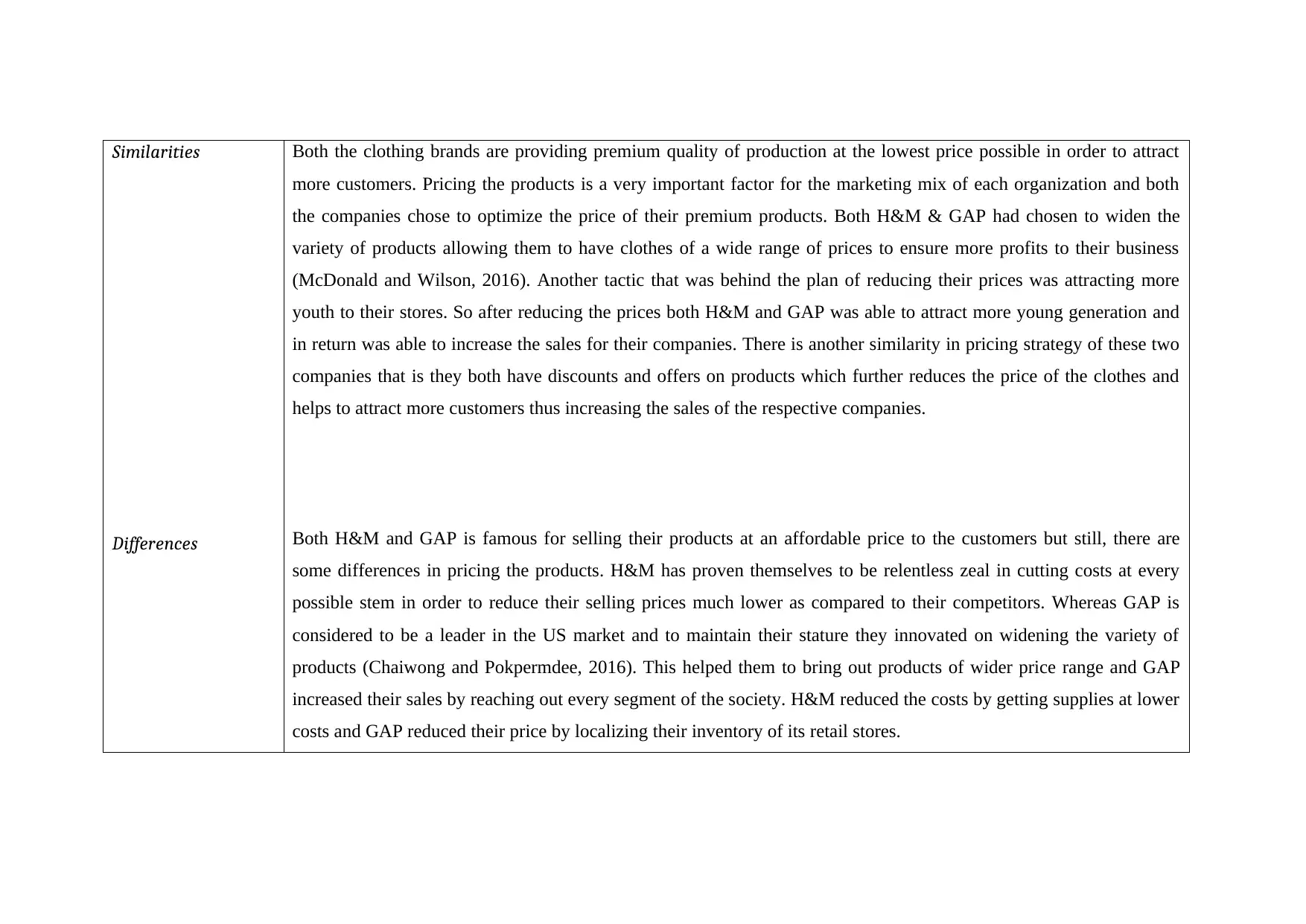
Similarities
Differences
Both the clothing brands are providing premium quality of production at the lowest price possible in order to attract
more customers. Pricing the products is a very important factor for the marketing mix of each organization and both
the companies chose to optimize the price of their premium products. Both H&M & GAP had chosen to widen the
variety of products allowing them to have clothes of a wide range of prices to ensure more profits to their business
(McDonald and Wilson, 2016). Another tactic that was behind the plan of reducing their prices was attracting more
youth to their stores. So after reducing the prices both H&M and GAP was able to attract more young generation and
in return was able to increase the sales for their companies. There is another similarity in pricing strategy of these two
companies that is they both have discounts and offers on products which further reduces the price of the clothes and
helps to attract more customers thus increasing the sales of the respective companies.
Both H&M and GAP is famous for selling their products at an affordable price to the customers but still, there are
some differences in pricing the products. H&M has proven themselves to be relentless zeal in cutting costs at every
possible stem in order to reduce their selling prices much lower as compared to their competitors. Whereas GAP is
considered to be a leader in the US market and to maintain their stature they innovated on widening the variety of
products (Chaiwong and Pokpermdee, 2016). This helped them to bring out products of wider price range and GAP
increased their sales by reaching out every segment of the society. H&M reduced the costs by getting supplies at lower
costs and GAP reduced their price by localizing their inventory of its retail stores.
Differences
Both the clothing brands are providing premium quality of production at the lowest price possible in order to attract
more customers. Pricing the products is a very important factor for the marketing mix of each organization and both
the companies chose to optimize the price of their premium products. Both H&M & GAP had chosen to widen the
variety of products allowing them to have clothes of a wide range of prices to ensure more profits to their business
(McDonald and Wilson, 2016). Another tactic that was behind the plan of reducing their prices was attracting more
youth to their stores. So after reducing the prices both H&M and GAP was able to attract more young generation and
in return was able to increase the sales for their companies. There is another similarity in pricing strategy of these two
companies that is they both have discounts and offers on products which further reduces the price of the clothes and
helps to attract more customers thus increasing the sales of the respective companies.
Both H&M and GAP is famous for selling their products at an affordable price to the customers but still, there are
some differences in pricing the products. H&M has proven themselves to be relentless zeal in cutting costs at every
possible stem in order to reduce their selling prices much lower as compared to their competitors. Whereas GAP is
considered to be a leader in the US market and to maintain their stature they innovated on widening the variety of
products (Chaiwong and Pokpermdee, 2016). This helped them to bring out products of wider price range and GAP
increased their sales by reaching out every segment of the society. H&M reduced the costs by getting supplies at lower
costs and GAP reduced their price by localizing their inventory of its retail stores.
Paraphrase This Document
Need a fresh take? Get an instant paraphrase of this document with our AI Paraphraser
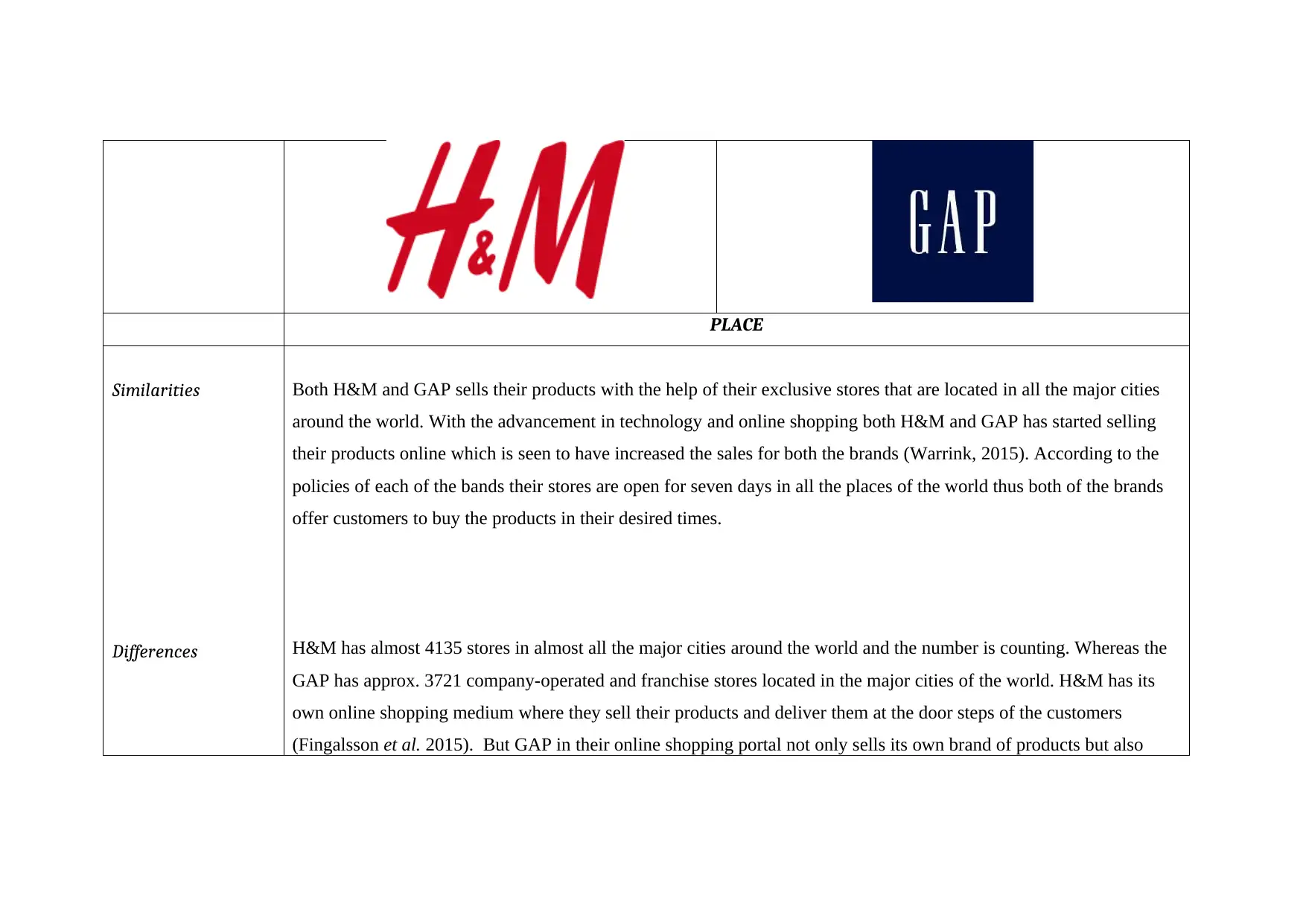
PLACE
Similarities
Differences
Both H&M and GAP sells their products with the help of their exclusive stores that are located in all the major cities
around the world. With the advancement in technology and online shopping both H&M and GAP has started selling
their products online which is seen to have increased the sales for both the brands (Warrink, 2015). According to the
policies of each of the bands their stores are open for seven days in all the places of the world thus both of the brands
offer customers to buy the products in their desired times.
H&M has almost 4135 stores in almost all the major cities around the world and the number is counting. Whereas the
GAP has approx. 3721 company-operated and franchise stores located in the major cities of the world. H&M has its
own online shopping medium where they sell their products and deliver them at the door steps of the customers
(Fingalsson et al. 2015). But GAP in their online shopping portal not only sells its own brand of products but also
Similarities
Differences
Both H&M and GAP sells their products with the help of their exclusive stores that are located in all the major cities
around the world. With the advancement in technology and online shopping both H&M and GAP has started selling
their products online which is seen to have increased the sales for both the brands (Warrink, 2015). According to the
policies of each of the bands their stores are open for seven days in all the places of the world thus both of the brands
offer customers to buy the products in their desired times.
H&M has almost 4135 stores in almost all the major cities around the world and the number is counting. Whereas the
GAP has approx. 3721 company-operated and franchise stores located in the major cities of the world. H&M has its
own online shopping medium where they sell their products and deliver them at the door steps of the customers
(Fingalsson et al. 2015). But GAP in their online shopping portal not only sells its own brand of products but also
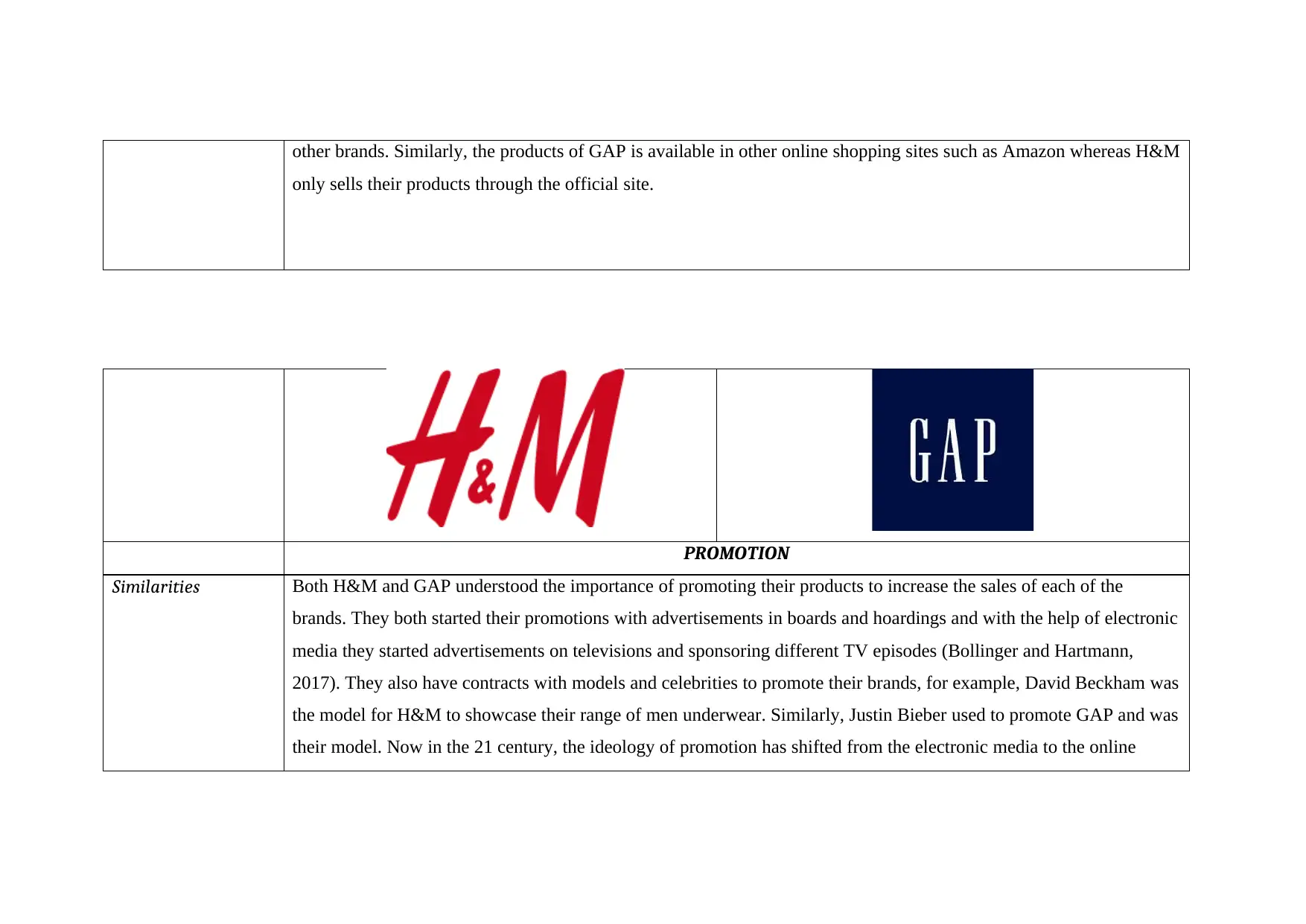
other brands. Similarly, the products of GAP is available in other online shopping sites such as Amazon whereas H&M
only sells their products through the official site.
PROMOTION
Similarities Both H&M and GAP understood the importance of promoting their products to increase the sales of each of the
brands. They both started their promotions with advertisements in boards and hoardings and with the help of electronic
media they started advertisements on televisions and sponsoring different TV episodes (Bollinger and Hartmann,
2017). They also have contracts with models and celebrities to promote their brands, for example, David Beckham was
the model for H&M to showcase their range of men underwear. Similarly, Justin Bieber used to promote GAP and was
their model. Now in the 21 century, the ideology of promotion has shifted from the electronic media to the online
only sells their products through the official site.
PROMOTION
Similarities Both H&M and GAP understood the importance of promoting their products to increase the sales of each of the
brands. They both started their promotions with advertisements in boards and hoardings and with the help of electronic
media they started advertisements on televisions and sponsoring different TV episodes (Bollinger and Hartmann,
2017). They also have contracts with models and celebrities to promote their brands, for example, David Beckham was
the model for H&M to showcase their range of men underwear. Similarly, Justin Bieber used to promote GAP and was
their model. Now in the 21 century, the ideology of promotion has shifted from the electronic media to the online
⊘ This is a preview!⊘
Do you want full access?
Subscribe today to unlock all pages.

Trusted by 1+ million students worldwide
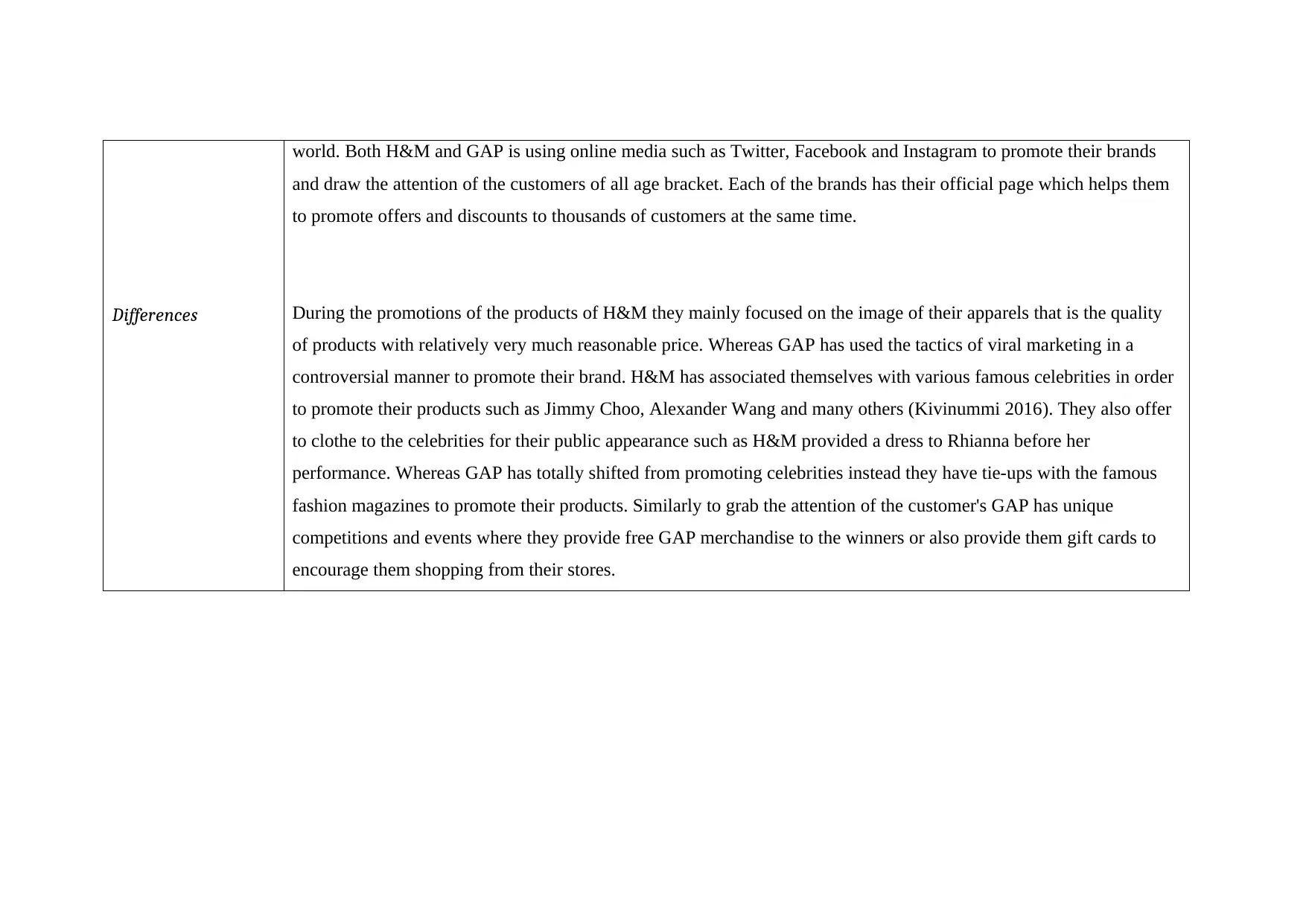
Differences
world. Both H&M and GAP is using online media such as Twitter, Facebook and Instagram to promote their brands
and draw the attention of the customers of all age bracket. Each of the brands has their official page which helps them
to promote offers and discounts to thousands of customers at the same time.
During the promotions of the products of H&M they mainly focused on the image of their apparels that is the quality
of products with relatively very much reasonable price. Whereas GAP has used the tactics of viral marketing in a
controversial manner to promote their brand. H&M has associated themselves with various famous celebrities in order
to promote their products such as Jimmy Choo, Alexander Wang and many others (Kivinummi 2016). They also offer
to clothe to the celebrities for their public appearance such as H&M provided a dress to Rhianna before her
performance. Whereas GAP has totally shifted from promoting celebrities instead they have tie-ups with the famous
fashion magazines to promote their products. Similarly to grab the attention of the customer's GAP has unique
competitions and events where they provide free GAP merchandise to the winners or also provide them gift cards to
encourage them shopping from their stores.
world. Both H&M and GAP is using online media such as Twitter, Facebook and Instagram to promote their brands
and draw the attention of the customers of all age bracket. Each of the brands has their official page which helps them
to promote offers and discounts to thousands of customers at the same time.
During the promotions of the products of H&M they mainly focused on the image of their apparels that is the quality
of products with relatively very much reasonable price. Whereas GAP has used the tactics of viral marketing in a
controversial manner to promote their brand. H&M has associated themselves with various famous celebrities in order
to promote their products such as Jimmy Choo, Alexander Wang and many others (Kivinummi 2016). They also offer
to clothe to the celebrities for their public appearance such as H&M provided a dress to Rhianna before her
performance. Whereas GAP has totally shifted from promoting celebrities instead they have tie-ups with the famous
fashion magazines to promote their products. Similarly to grab the attention of the customer's GAP has unique
competitions and events where they provide free GAP merchandise to the winners or also provide them gift cards to
encourage them shopping from their stores.
Paraphrase This Document
Need a fresh take? Get an instant paraphrase of this document with our AI Paraphraser
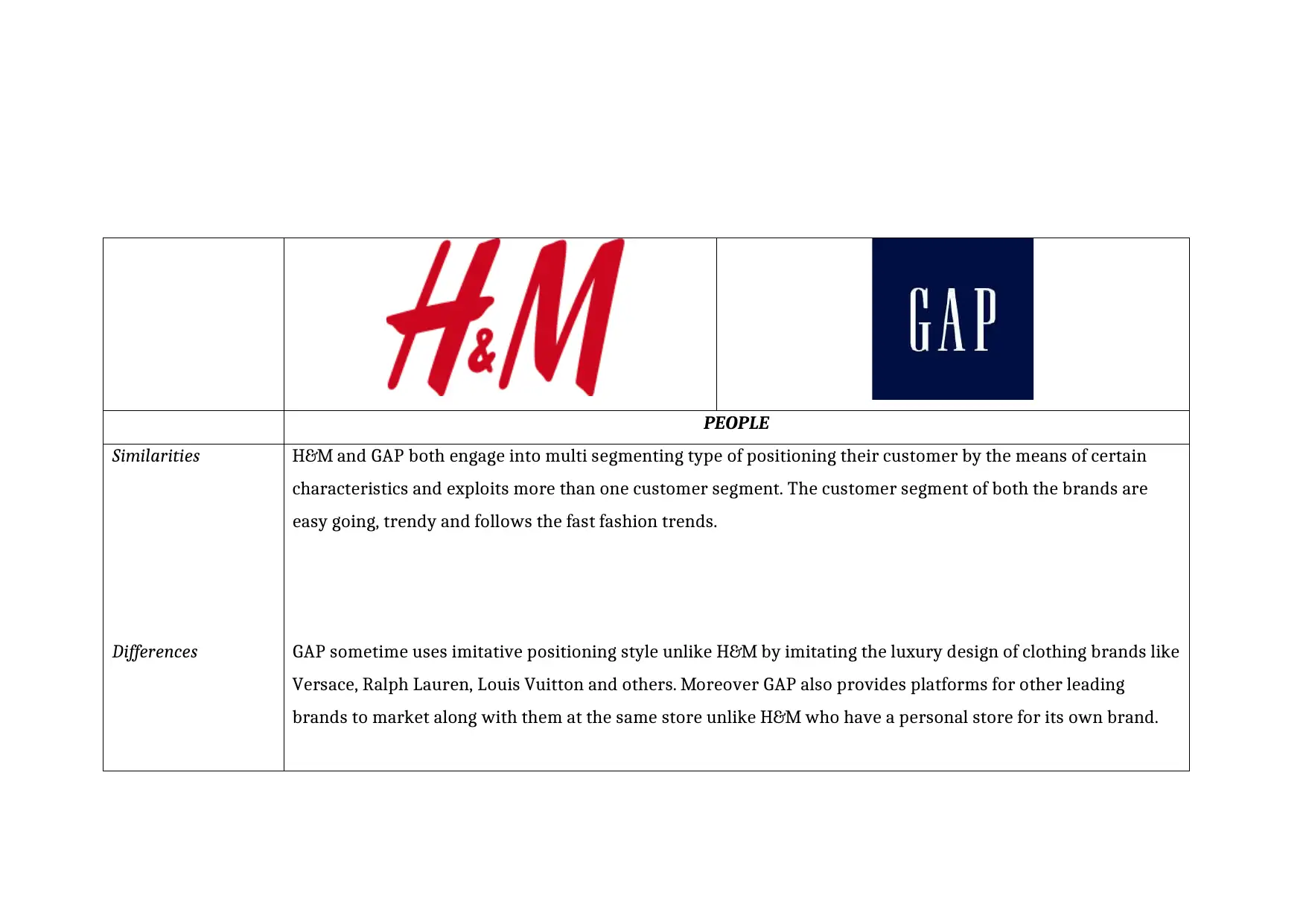
PEOPLE
Similarities
Differences
H&M and GAP both engage into multi segmenting type of positioning their customer by the means of certain
characteristics and exploits more than one customer segment. The customer segment of both the brands are
easy going, trendy and follows the fast fashion trends.
GAP sometime uses imitative positioning style unlike H&M by imitating the luxury design of clothing brands like
Versace, Ralph Lauren, Louis Vuitton and others. Moreover GAP also provides platforms for other leading
brands to market along with them at the same store unlike H&M who have a personal store for its own brand.
Similarities
Differences
H&M and GAP both engage into multi segmenting type of positioning their customer by the means of certain
characteristics and exploits more than one customer segment. The customer segment of both the brands are
easy going, trendy and follows the fast fashion trends.
GAP sometime uses imitative positioning style unlike H&M by imitating the luxury design of clothing brands like
Versace, Ralph Lauren, Louis Vuitton and others. Moreover GAP also provides platforms for other leading
brands to market along with them at the same store unlike H&M who have a personal store for its own brand.
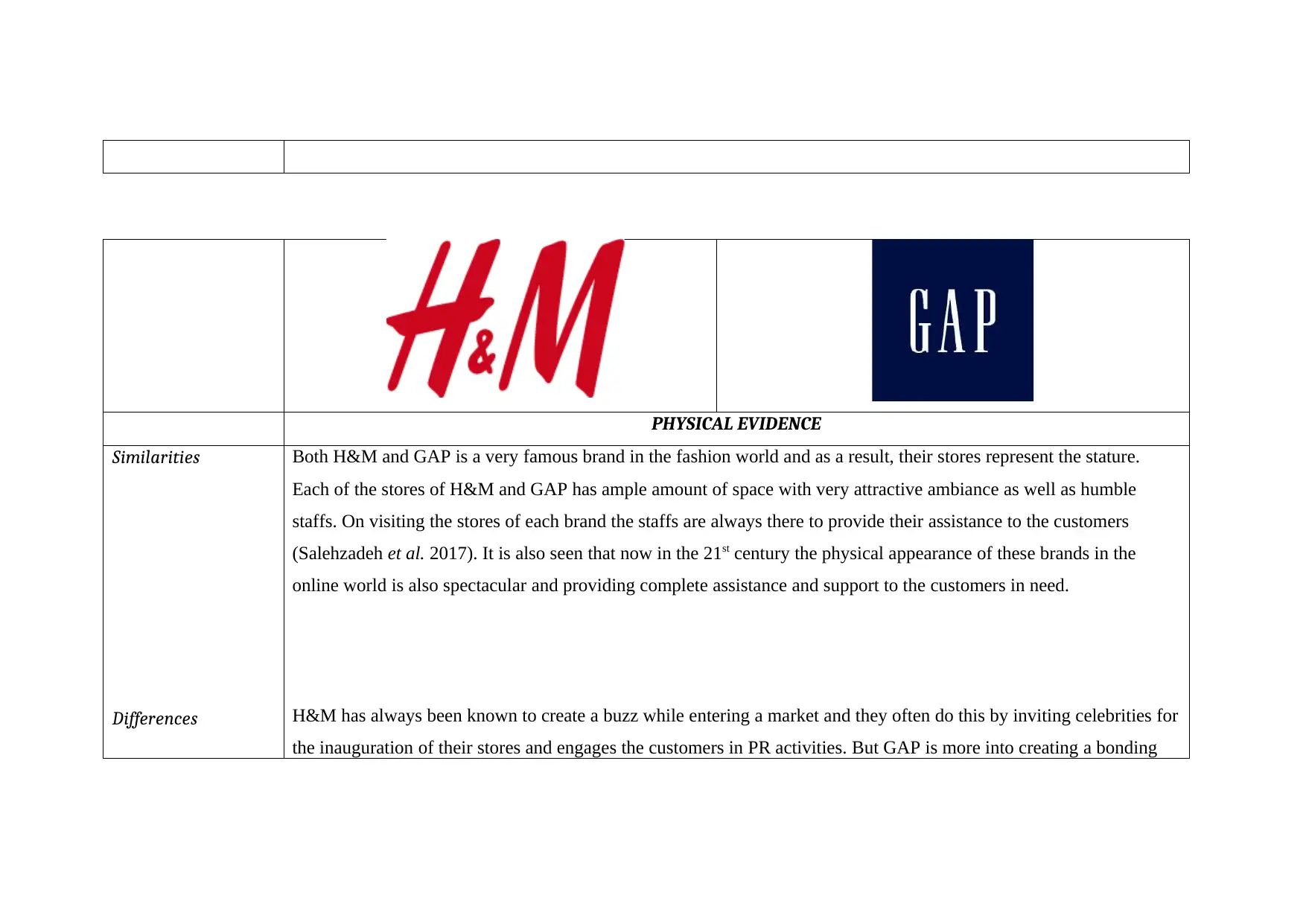
PHYSICAL EVIDENCE
Similarities
Differences
Both H&M and GAP is a very famous brand in the fashion world and as a result, their stores represent the stature.
Each of the stores of H&M and GAP has ample amount of space with very attractive ambiance as well as humble
staffs. On visiting the stores of each brand the staffs are always there to provide their assistance to the customers
(Salehzadeh et al. 2017). It is also seen that now in the 21st century the physical appearance of these brands in the
online world is also spectacular and providing complete assistance and support to the customers in need.
H&M has always been known to create a buzz while entering a market and they often do this by inviting celebrities for
the inauguration of their stores and engages the customers in PR activities. But GAP is more into creating a bonding
Similarities
Differences
Both H&M and GAP is a very famous brand in the fashion world and as a result, their stores represent the stature.
Each of the stores of H&M and GAP has ample amount of space with very attractive ambiance as well as humble
staffs. On visiting the stores of each brand the staffs are always there to provide their assistance to the customers
(Salehzadeh et al. 2017). It is also seen that now in the 21st century the physical appearance of these brands in the
online world is also spectacular and providing complete assistance and support to the customers in need.
H&M has always been known to create a buzz while entering a market and they often do this by inviting celebrities for
the inauguration of their stores and engages the customers in PR activities. But GAP is more into creating a bonding
⊘ This is a preview!⊘
Do you want full access?
Subscribe today to unlock all pages.

Trusted by 1+ million students worldwide
1 out of 22
Related Documents
Your All-in-One AI-Powered Toolkit for Academic Success.
+13062052269
info@desklib.com
Available 24*7 on WhatsApp / Email
![[object Object]](/_next/static/media/star-bottom.7253800d.svg)
Unlock your academic potential
Copyright © 2020–2025 A2Z Services. All Rights Reserved. Developed and managed by ZUCOL.



